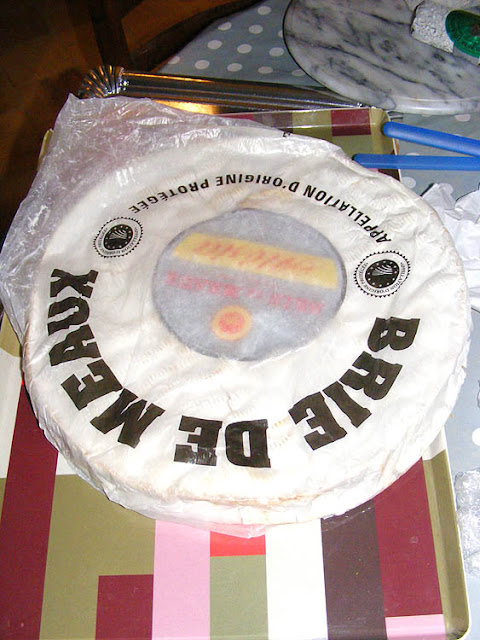Non-French readers may be unaware that there are two types of Brie cheese in France. You rarely see Brie de Melun because the production is so small, but Brie de Meaux is readily available. As the name suggests this cheese comes from the area around Meaux, to the east of Paris.
It is a raw cow's milk cheese, with a squidgy interior and a velvety white blooming crust. Each cheese weighs on average 2.8 kilograms and is 36-37 centimetres in diametre. Inside the cheese is pale straw yellow, unctuous and cushiony. It will get runny with age, which we quite like, but strictly speaking it is considered at its best just before that point.
It is believed to have originated in the Benedictine Abbey of Notre-Dame de Jouarre, in Seine et Marne, and was described as a cheese 'loved by rich and poor' in the 18th century. Talleyrand declared it the King of Cheeses. Since the 1950s production has tended to move from around Meaux to further east towards Meuse. Seventy percent of production now comes from south of Meuse.
Like many things in France, it is seasonal, at its best from April to September, after a 8-10 week maturing, when it will be a bit nutty and a bit lactic. The longer it is matured the stronger it gets. It is quite an easy going cheese as far as wine pairings go, and can be served with Burgundies, Côtes de Rhone, champagne or cider (which is what it is often paired with by those who live in the area it is made in).
It takes 25 litres of milk to make a single cheese. The milk is fermented in a trough for 16 hours then put under pressure to form curd which is then cut into small cubes. After that it is gently scooped into a mould, layer by layer. The temperature is raised, then lowered over a number of hours and the cheese is set in its mould onto rushes to drain. The next day it is tipped out of the mould and salted, then left for a couple of days. Then it has a week at cellar temperature (12C). By now it will have started to develop the white crust and it will be put in a colder room (7C) to finish maturing, during which time it will be turned by hand. Brie de Meaux is usually sold at two months old.
Just over 6000 tonnes a year are produced and production is decreasing year on year. There are 7 maker-maturers, 3 maturers, and 8 factories, taking milk from 443 dairy farms.
We are also on Instagram, so check us out to see a regularly updated selection of our very best photos.




3 comments:
Brie is one of my favorite cheeses?
I love it when it's 'ambulant' !
"Brie de Meaux is usually sold at two months old."
Except in the UK where it is sold at six years and has to be caged!!
Fresh brie and a pear and some very fresh, malted brown bread.... no need for butter, just feed a chunk of brie, then a bite of pear and some bread into your maw and chew.... very slowly to mix the flavours slowly, slowly, slowly.... and wash it down with some cider or, even better.... perry!!
Pause, repeat, pause, repeat.....................................
Post a Comment